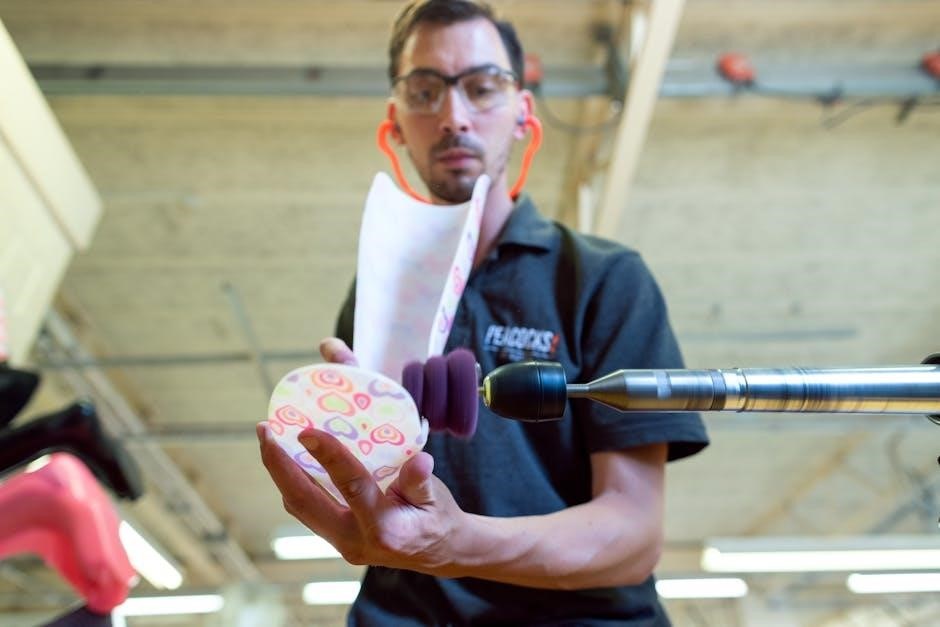Engineering Design Process Worksheet PDF: A Comprehensive Guide
This comprehensive guide introduces the Engineering Design Process Worksheet PDF‚ a valuable tool for students and professionals alike. This resource aids in navigating the problem-solving journey‚ fostering innovation and effective solutions to challenges.
The Engineering Design Process (EDP) is a systematic‚ iterative approach used by engineers and problem-solvers to develop solutions to complex challenges. More than just a series of steps‚ the EDP fosters a mindset of open-ended problem-solving‚ encouraging creativity‚ critical thinking‚ and learning from both successes and failures. This process applies across various fields‚ from constructing bridges to designing software‚ and is essential for innovation.
At its core‚ the EDP is about understanding a problem‚ brainstorming potential solutions‚ building and testing prototypes‚ and refining designs based on feedback. It is a cyclical process‚ meaning that steps may be revisited and repeated as needed to optimize the final solution. The EDP emphasizes collaboration‚ communication‚ and a willingness to adapt and improve. This introduction aims to highlight the importance of the EDP and its role in fostering a generation of creative and effective problem-solvers.
Understanding the Steps of the Engineering Design Process

The Engineering Design Process is not a rigid‚ linear sequence but rather a cyclical and iterative framework. The core steps generally include identifying the problem‚ researching and brainstorming potential solutions‚ developing and prototyping designs‚ testing and evaluating their effectiveness‚ and refining the design based on the results. Each stage plays a crucial role in arriving at the final solution. Understanding these steps is essential for anyone embarking on an engineering project.
The process begins with a clear definition of the problem‚ including any constraints or limitations. Next‚ thorough research and brainstorming generate a range of possible solutions. Prototypes are then created to test and evaluate these ideas. The results of testing are used to refine and improve the design iteratively‚ ensuring that the final product meets the initial needs and requirements. This iterative approach allows for continuous learning and optimization throughout the design process.
Identifying the Problem: Defining the Need
The initial step of the Engineering Design Process is clearly defining the problem. This involves understanding the need or challenge that the design aims to address. A well-defined problem statement serves as the guiding principle throughout the entire process. It should articulate the core issue‚ the goals to be achieved‚ and any constraints or limitations that must be considered. Without a clear problem definition‚ the design process can become unfocused and inefficient.
A clearly defined problem statement should answer questions such as: What is the specific issue to be resolved? Who is affected by the problem? What are the desired outcomes of the solution? What are the limitations or constraints that must be considered‚ such as budget‚ time‚ or available resources? By thoroughly addressing these questions‚ engineers can ensure that their efforts are directed towards a relevant and achievable goal. Defining the need sets the stage for successful problem-solving and innovation.
Research and Brainstorming: Generating Ideas
Once the problem is well-defined‚ the next crucial step involves thorough research and brainstorming to generate potential solutions; Research entails gathering information about existing solutions‚ relevant technologies‚ and any constraints that might influence the design process. This step ensures that the design is informed by current knowledge and best practices. Brainstorming‚ on the other hand‚ is a creative process aimed at generating a wide range of ideas without initial judgment. It encourages participants to think outside the box and explore unconventional approaches.
Effective brainstorming sessions involve creating a collaborative environment where all ideas are welcomed and encouraged. Techniques such as mind mapping‚ sketching‚ and role-playing can be used to stimulate creative thinking. The goal is to generate a diverse set of potential solutions that can be further evaluated and refined. It’s important to document all ideas‚ even those that seem impractical at first‚ as they may spark new insights or lead to unexpected breakthroughs. Research and brainstorming lay the foundation for innovative and effective design solutions.
Developing Solutions: Creating Prototypes
Following the brainstorming and research phase‚ the focus shifts to developing tangible solutions. This involves selecting the most promising ideas and translating them into detailed designs. Engineering Design Process worksheets often provide structured templates for sketching out design concepts‚ specifying materials‚ and outlining the functionality of the proposed solution. These worksheets encourage a systematic approach‚ ensuring that all aspects of the design are carefully considered.
A crucial part of this stage is the creation of prototypes. Prototypes are preliminary models or versions of the design‚ built to test and refine its functionality; They can range from simple paper models to sophisticated digital simulations. The purpose of prototyping is to identify potential flaws‚ assess the feasibility of the design‚ and gather feedback for improvement. The iterative process of designing‚ building‚ and testing prototypes is essential for arriving at a robust and effective final solution. Prototypes serve as a bridge between conceptual ideas and real-world implementation.
Testing and Evaluation: Analyzing Results
After developing prototypes‚ the next critical step is rigorous testing and evaluation. This phase involves subjecting the prototypes to a series of tests designed to assess their performance against the pre-defined criteria and constraints. The Engineering Design Process worksheet often includes sections for documenting the testing procedures‚ recording observations‚ and analyzing the results. This systematic approach ensures that the evaluation is thorough and objective.

Analyzing the results is crucial for identifying areas where the prototype performs well and areas that require improvement. This involves comparing the prototype’s performance data to the initial design specifications and identifying any discrepancies. The worksheet may include prompts for analyzing the root causes of any failures or shortcomings. This analysis forms the basis for the next iteration of the design process. The goal is to gather data-driven insights that will guide the refinement of the solution and ensure that it meets the desired objectives.
Refining the Design: Iteration and Improvement
Based on the testing and evaluation results‚ the design enters a phase of refinement. This is an iterative process‚ meaning it involves repeating steps to gradually improve the design. The Engineering Design Process worksheet guides this process by providing sections for documenting the identified weaknesses and brainstorming potential improvements. This iterative approach allows for incorporating new knowledge and insights gained during testing.

Improvements may involve modifying the materials used‚ altering the design’s structure‚ or optimizing the functionality. Each modification should be carefully considered and documented. After implementing changes‚ the prototype is re-tested to evaluate the impact of the refinements. This cycle of testing‚ evaluation‚ and refinement continues until the design meets the required specifications. The worksheet serves as a record of all iterations‚ documenting the changes made and their corresponding results. This ensures transparency and facilitates collaboration within the engineering team.
Engineering Design Process Worksheets: Purpose and Benefits
Engineering Design Process worksheets serve as structured tools that guide individuals and teams through each stage of the design process. Their primary purpose is to facilitate a systematic approach to problem-solving‚ ensuring that all essential aspects of a design challenge are considered. By providing a framework for documenting ideas‚ research‚ and test results‚ these worksheets promote clarity‚ organization‚ and effective communication within a team.
The benefits of using Engineering Design Process worksheets are numerous. They help in breaking down complex problems into manageable steps. They encourage thorough research and brainstorming‚ leading to more innovative and well-considered solutions. Worksheets promote critical thinking and analysis by prompting users to evaluate different design options and justify their choices. The structured format assists in tracking progress‚ identifying potential issues‚ and making informed decisions throughout the design lifecycle. Ultimately‚ these worksheets enhance efficiency‚ reduce errors‚ and improve the overall quality of engineering designs.
Utilizing Worksheets in the Classroom
Engineering Design Process worksheets are invaluable tools for educators seeking to engage students in hands-on‚ problem-based learning. These worksheets can be effectively integrated into various subjects‚ from science and mathematics to technology and engineering courses. By providing a structured framework for tackling design challenges‚ worksheets help students develop critical thinking‚ problem-solving‚ and teamwork skills.

In the classroom‚ worksheets can be used to guide students through each stage of the Engineering Design Process‚ from identifying a problem to testing and refining solutions. Educators can use worksheets to introduce key concepts‚ facilitate brainstorming sessions‚ and encourage students to document their ideas and findings. Furthermore‚ worksheets provide a means for assessing student understanding and tracking progress throughout the design process. By incorporating Engineering Design Process worksheets into their curriculum‚ teachers can foster a more engaging and effective learning environment‚ preparing students for future success in STEM fields. They can also teach students about troubleshooting and redesign.
Example Problems and Solutions Using the Engineering Design Process
To illustrate the application of the Engineering Design Process‚ consider the challenge of designing a device to safely rescue a kitten trapped in a deep hole. The initial step involves defining the problem: the kitten is inaccessible and requires a safe extraction method. Research entails exploring existing rescue tools and techniques‚ considering factors like the hole’s depth and the kitten’s size and weight.
Brainstorming yields ideas such as a rope-and-bucket system‚ a modified grabber tool‚ or an inflatable cushion. A prototype grabber tool is built using readily available materials. Testing reveals its limitations in securely grasping the kitten. The design is refined by adding padding to the grabber’s claws. Subsequent testing demonstrates improved performance‚ successfully rescuing the kitten. This example showcases how the Engineering Design Process facilitates creative problem-solving through iterative design and testing.
The EDP’s emphasis on iteration and learning from failures promotes continuous improvement and adaptability‚ essential qualities in today’s dynamic world. By utilizing worksheets that guide users through each step of the process‚ individuals and teams can enhance their problem-solving skills and create impactful solutions to real-world challenges. Embracing the EDP empowers individuals to approach complex problems with confidence‚ creativity‚ and a structured methodology‚ ultimately leading to more successful outcomes in engineering‚ science‚ and beyond.